Clean River Water May Be a Viable Water Source For Some Communities
Clean river water may nearby and available and capable of being developed as a water source for some communities.
Note: The content on this page has been adapted from technical notes published by USAID, entitled “Water for the World”.
Rivers and streams are formed by surface run-off from rainfall or from snow and ice melting in colder regions.
Also, some rivers and streams have springs as their sources.
Rivers and streams have variable yield and water quality. Some rivers and streams dry up during the dry season and have no water for several months. People who depend on the clean river water are left with little or no water.
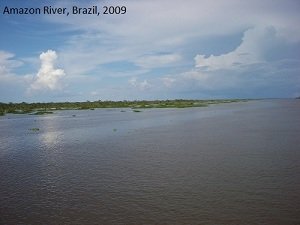
Rivers and streams are also exposed to contamination by waste disposal, laundry, bathing, and animals, and may prove unsuitable for drinking unless treated. In mountainous areas or in places with few inhabitants, the quality of clean river water can be very good, requiring little treatment. Streams in such areas offer a good source of water for a community.
There are three methods of developing streams and rivers and obtaining clean river water:
1. Intake through infiltration wells and galleries;
2. Direct intakes connected to mechanical pumps; and
3. Direct intakes using gravity flow.
Intakes provide a dependable method of “harvesting” the clean river water from a river or stream and will be needed if rivers and streams are to be used for a water supply. Intakes can provide sufficient water to a water supply system but there are special considerations which must be recognized for effective planning.
Rivers and streams generally have a wide seasonal variation that will affect the location of intakes and the quality of water drawn by them. During the wet season, water is abundant. However, flooding may occur which could destroy the intake and steps must be taken to protect it in the high water season.
In the dry season, water flow will lessen and may even disappear completely. In this case, a community dependent on clean river water as their water source would have to find an alternative.
In faster flowing streams and rivers, erosion along the riverbanks can be a problem. To prevent erosion, a flat, stable section of the stream should be chosen for the intake site rather than a winding section of the stream.
Efficient planning is necessary to ensure a year-round supply of clean river water from a river or stream. There are two types of intakes for rivers and streams;
1. Infiltration Wells and
2. Direct Intakes.
Infiltration Wells
As mentioned in the Groundwater section of this website, a well near a riverbank can be an excellent intake for a stream or river.
Referred to as an infiltration well, these can provide potable water from a surface source during the entire year if it is excavated below the stream bed level.
Water quality is good because as clean river water is pumped from the well, the stream water is drawn through the ground into the well.
As the water passes through the ground, suspended particles and bacteria are removed and the stream water is considerably purified. The purification process depends on the makeup of the soil in the river bank and the distance of the well from the stream or river.
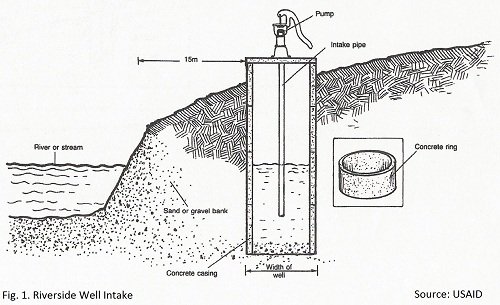
If the soil is made up of large particles, the water will pass through it quickly. Soil containing finer particles of sand and silty clay slows the movement of water. The slower the water moves, the less distance it must travel for filtration to take place.
In fine or compacted soils, the well could be placed as close to the river as 2 or 3m. In coarser soils, the well may have to be 20 or 25m from the stream so that the water will flow underground long enough to be purified.
In semicoarse soils, a distance or l0-15m from the stream should be sufficient.
Be sure that the soil is not highly compacted clay. Water movement through compacted clay is very slow and the replenishment of the well could also be very slow.
Another advantage of an infiltration well is that clean river water is usually available even in seasons when the river dries up. Water is stored in the soil and in the well.
If the river is likely to dry up and no other suitable source is available, be sure to dig lower than the bed of the stream and plan a well with a large storage capacity. Figure 1 shows the process of infiltration at a riverside well.
Infiltration Galleries
An infiltration gallery is a horizontally placed perforated pipe or well screen that is installed in such a manner as to collect groundwater adjacent to a stream.
Infiltration galleries are developed in basically the same way as infiltration wells, except that collecting pipes are installed instead of a well being dug.
Riverbanks with firm soil that does not contain a lot of clay are good for infiltration galleries. Some infiltration galleries are built in the bank parallel to the stream.
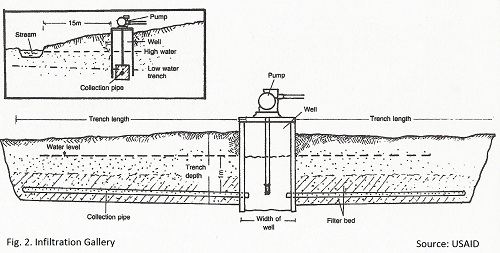
For an infiltration gallery, trenches are dug to a depth below the water level and collecting pipes are installed as shown in Figure 2.
The pipes channel water into a well which provides some storage and settling. The distance of an infiltration gallery from the river or stream depends on the soil makeup.
Filtration is usually very good because each collection pipe is protected by a layer or sand and gravel which filters out sediment. As the water moves from the stream to the trenches, bacteria are filtered from it and the result is clean river water.
If soil is sandy, this type of infiltration gallery may not work. The sand may clog the collection pipes and cut off the flow of water. Sandy soil is not firm which makes deep excavation dangerous due to cave-ins. Where there are sandy river banks, another alternative should be found.
In some streams, the collection pipes can be laid directly in the stream bed as shown in Figure 8. For installation, the stream can be bailed out or have its flow diverted and a trench 0.5 - 0.7m deep dug out.
A collection pipe surrounded by gravel can be placed in the trench and connected by another pipe to a well on the shore. This type of infiltration gallery is best installed during the dry season.
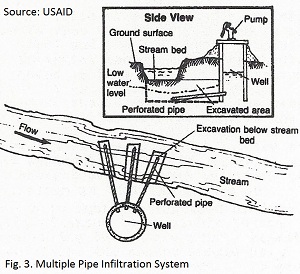
Another possibility is to place the pipes under the stream bed, perpendicular to the stream as shown in Figure 3. This technique requires that the pipes be driven into the stream bed. This type of infiltration gallery is much more difficult to build, but is useful when the other two methods cannot be used.
With infiltration galleries, often times it is best to use fine filtering materials to slow the velocity of water entering the system. The lower velocity provides clearer water, but less quantity. To maintain the quantity desired, infiltration galleries can be made longer in order to collect water over a larger area.
Infiltration galleries can provide large quantities of good quality water because water is collected over a large area. Infiltration wells generally serve only a few users, while infiltration galleries can serve entire communities.
Direct River Intakes
Clean river water can be assured by locating the intake directly in the river, above inhabited areas and sources of contamination. In many cases, there is little chance of fecal contamination by people or animals, especially in areas where few people live.
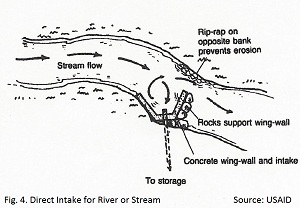
Direct intake structures should be located either on a straight, stable section of a river bank or else near the convex side of the bank as shown in Figure 4. Be sure that the bank is stable when choosing the location. The intake should be located so that it is submerged all year long.
Before attempting to install an intake in a specific location, determine the low water level during the dry season. The intake should be low enough to collect water all year but not too close to the bottom where sediment or rock could enter and clog it.
Many times streams are not very deep and, especially for gravity flow intakes, it will be necessary to introduce techniques which ensure a constant flow through the intake.
A weir or submerged dam can be built across the river to raise the water level enough to provide the necessary flow. The intake must be submerged at all times.
In a deeper and faster stream, the intake can be located in a concrete ring attached to the shore by a catwalk. The ring is placed in the stream and protects the intake from damage, from debris, and the force of the water.
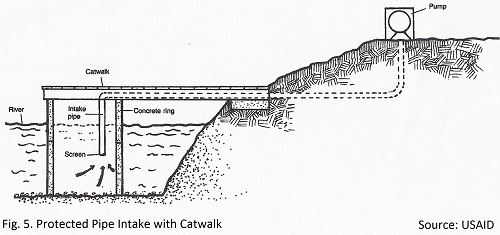
The catwalk is attached to the ring from the shore to provide access for maintenance. The intake is connected to a mechanical pump. This type of intake is generally expensive to construct, operate, and maintain, and skilled people must be available for its construction.
Intakes for rivers and streams should be located as close as possible to the users. The expense of piping water over long distances must always be considered when planning to use a source.
Where possible, a river intake should take advantage of the purification process that accompanies an infiltration system, as described above, so treatment can be avoided.
Direct river intakes provide no such filtration. Also, if the installation of a gravity system is possible, the costs of pumping water to the users will not be a burden.
Gravity Flow Intakes
Water from a stream can be carried to the user through a gravity flow system. This method is suitable for streams and rivers with enough changes in elevation to allow gravity to move the water from the intake to the storage tank.
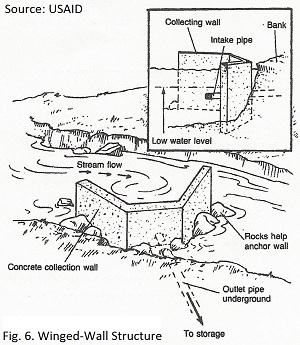
A concrete collection box with winged sides can be constructed to catch water and direct it into a screened intake. The intake should be placed on the stream bed and anchored to the bank as shown in Figure 6.
Water will then pass from the intake into the storage tank. No pumping will be necessary to supply a community with water, so little maintenance will be required. However, highly skilled technicians are needed to design and construct the system. As with the other methods, treatment will be necessary.
In streams with sufficient fall, a hydraulic ram may be used to pump clean river water to storage. The ram is an inexpensive and easily-maintained pump and can be constructed in the community. The ram is able to lift water from a stream into a storage tank without using an outside source or power.
Highly-skilled labor is usually needed for construction involved in developing rivers and streams. This will add to the cost of the project.
As a general rule, stream water in low areas and estuaries is contaminated and will need some degree of treatment. Streams that are not exposed to human and animal wastes, and those at higher elevations with little population, will provide clean river water with little treatment.
Special care must be taken to choose a source located above inhabited areas if treatment options and few.
Return to "Surface Water" from "Clean River Water"
Return to "Home"









